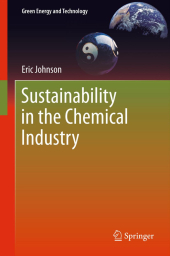 Neuerscheinungen 2014Stand: 2020-02-01 |
Schnellsuche
ISBN/Stichwort/Autor
|
Herderstraße 10
10625 Berlin
Tel.: 030 315 714 16
Fax 030 315 714 14
info@buchspektrum.de |

Eric Johnson
Sustainability in the Chemical Industry
2012. 2014. xvi, 176 S. 15 Tabellen. 235 mm
Verlag/Jahr: SPRINGER NETHERLANDS; SPRINGER 2014
ISBN: 9401781559 (9401781559)
Neue ISBN: 978-9401781558 (9789401781558)
Preis und Lieferzeit: Bitte klicken
It´s the new rock and roll. It´s the new black. Sustainability is trendy, and not just among hipsters and pop stars. The uncool chemical sector helped pioneer it, and today, companies inside and outside the sector have embraced it. But what have they embraced? Surely not the Brundtland definition of meeting "the needs of the present without compromising the ability of future generations to meet their own needs."
Sustainability describes a change in the chemical industry´s approach to the external world: to regulators, to greens, to neighbors, to investors and to the general public. Displacing the adversarialism of the 1970s-80s, sustainability is a new approach to social/political conflict, and an attempt to rebuild the industry´s long-suffering public image. In practice, it consists of:
A ´stakeholder´ approach to communications and external relations
A rebranding of regulatory compliance and risk management, with the emphasis on their benefits to stakeholders
Recognition (and even celebration) of the opportunities, not just the costs, of environmental and social protection
The core of this book is a survey of the world´s 29 largest chemical companies: how they put sustainability into action (six of the 29 do not), and the six ´sustainability brands´ they have created. It begins with a history of stakeholders conflict, before looking at various definitions of sustainability - by academics, by the public and by investors. After the survey and analysis, the book covers sustainability and ´greenwash´ plus the ROI of sustainability, and it gives five recommendations.
1 ABSTRACT.
2 FOREWORD : WHY THIS BOOK? 2.1 Review Of Existing Literature. 2.2 Needed: An Empirical Review.
3 SUMMARY : SUSTAINABILITY IS ADVANCING, WITH MORE CHANGES TO COME. 3.1 Sustainability In Practice: Communications, Regulatory Compliance, Risk Management. 3.2 Sustainability Defined. 3.3 Is Sustainability Inevitable, And Does It Pay? 3.4 Sustainability´S Limits. 3.5 Are The Causes For Sustainability Obsolete? 3.6 Making Sustainability Sustainable.
4 INTRODUCTION : SUSTAINABILITY´S BANDWAGON HAS LEFT THE STATION, BUT WHERE IS IT HEADED?
5 WHY THE CHEMICAL INDUSTRY TURNED TO SUSTAINABILITY . 5.1 How The Chemical Industry Upsets The Public. 5.2 How Regulation Has Harmed The Industry´S Image. 5.3 The Battle Of Litanies: Regulators Versus Industry. 5.4 Losing The License To Operate? 5.5 Sustainability: A Way To Keep The License, A Way To Influence Regulation. 5.6 For The Chemical Industry, Sustainability Is Conciliation.
6 HOW OTHERS DEFINE SUSTAINABILITY. 6.1 The Popular View Of Sustainability. 6.2 The Theoretical (Academic) View Of Sustainability. 6.3 The Financial Market View Of Sustainability.
7 HOW CHEMICAL COMPANIES DEFINE SUSTAINABILITY, IN PRACTICE . 7.1 Research Method. 7.2 Sustainability Within The Corporate Organization. 7.3 Stakeholder Approach To Communications. 7.4 Rebranding Regulatory Compliance And Risk Management. 7.5 Recognition/Celebration Of Green Opportunities.
8 SUSTAINABILITY ´BRANDS´. 8.1 How The Leading 29 Chemical Companies Stack Up. 8.2 Why The Variations In Branding? 8.3 What About Sustainability Crusaders? 8.4 The Limits Of Sustainability.
9 THE THIN GREEN LINE : BETWEEN SUSTAINABILITY AND GREENWASH. 9.1 Lying. 9.2 Spinning Words And Science. 9.3 Celebrating Compliance. 9.4 Celebrating Green Products And Processes. 9.5 Green Endorsements.
10 EVALUATING SUSTAINABILITY : IS IT NECESSARY, AND DOES IT PAY? 10.1 Academic Studies Of Sustainability´S Benefits Are Inconclusive. 10.2 Sustainability Makes For A More Attractive Employer. 10.3 Sustainability As A Way Out Of Crisis? Not Obvious. 10.4 How Stakeholders React To Sustainability. 10.5 Sustainability Successes. 10.6 Sustainability Failures. 10.7 Is Sustainability Profitable, And Should It Be?
11 IS THERE A NON-SUSTAINABLE OPTION ? 11.1 Cigarette Producers. 11.2 Armament Makers. 11.3 Albemarle.
12 GET ON SUSTAINABILITY´S BANDWAGON, BUT NOT BLINDLY OR BLITHELY . 12.1 Study Your Stakeholders. 12.2 Consider The Corporate Position And Culture. 12.3 Be Responsive, Not Necessarily Responsible. 12.4 Sustainability And Responsibility: Right Ideas, Wrong Words. 12.5 Remember The Risks. 12.6 Return To A Safety Culture?
13 APPENDIX 1: Company Classification.
14 APPENDIX 2: Quantity Versus Quality - How Experts And Laypeople Disagree About Technology Risks. 14.1 Quantitative - Approach Of The Experts. 14.2 Not Just Whether You Die, But How. 14.3 The Leading Cause Of Death? Life.
15 REFERENCES.


